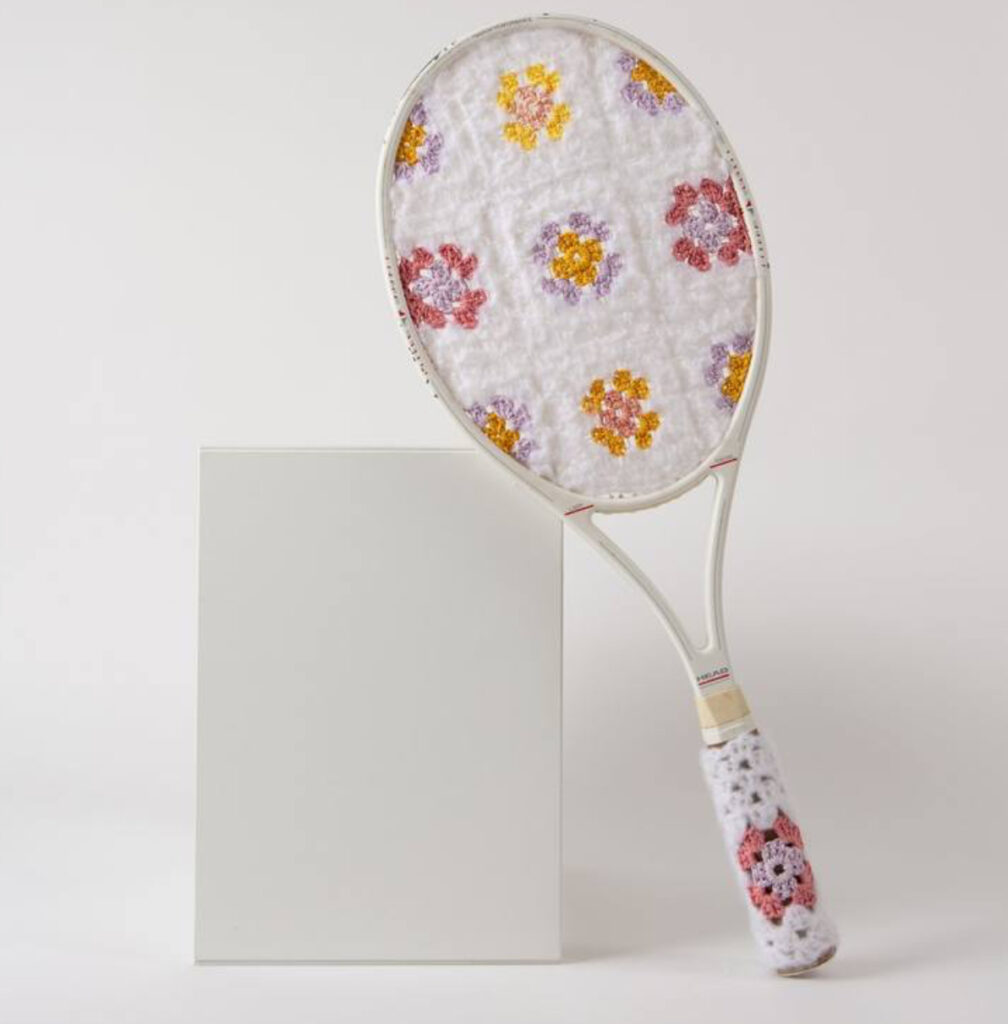In a gallery corner filled with ambient stillness, there stands a work that seems to breathe without moving—“Jeu Double en Blanc” by French sculptor Sophie Inard, a structure so restrained in palette yet so rich in tension that it stops the viewer mid-thought. It doesn’t impose itself, nor does it chase interpretation. Rather, it radiates presence through the repetition of gesture, the tactility of fiber, and the formal contradictions of soft meeting synthetic.
Constructed from crochet layered over plastic, the piece is an act of both concealment and articulation. Its title—Jeu Double, or “Double Game”—immediately introduces a dialectic, a suggestion that the sculpture isn’t singular in meaning, but doubled in motive, split in symmetry or intent. “En Blanc” ties it to the ghostly, the minimal, the ceremonial. It is a work that resides not in noise or narrative, but in the slow choreography of texture and shadow.
The Artist and Her Lexicon of Fiber
Sophie Inard, based in France, is part of a generation of sculptors reexamining femininity, labor, and language through textile art. Her material choices—often humble, domestic, and tactile—are re-contextualized through sculptural formalism. Crochet, in her hands, becomes not just a technique but a kind of calligraphy, an act of stitching meaning across spatial dimensions.
Inard’s work speaks fluently in material paradox: delicate yet structural, private yet public, labor-intensive yet whisper-quiet. Her vocabulary centers around process—specifically the slow, repetitive motions of handcraft as a form of meditation, resistance, and memory inscription. Jeu Double en Blanc is arguably a summation of her core practice: a minimalist object charged with intimate emotional architecture.
Material Composition: Crochet and Plastic in Tension
To understand Jeu Double en Blanc, one must begin with its materials. Plastic, synthetic and industrial, serves as the inner scaffolding—rigid, unseen, holding the form. Around this core is wrapped crochet, done in a soft white thread that varies subtly in shade under shifting light.
Plastic and crochet are not natural companions. Plastic is extruded, impersonal, cold; crochet is handmade, looped from warmth and gesture. By enwrapping one in the other, Inard creates a skin over structure, one that obscures even as it reveals. The crochet does not simply decorate the plastic—it domesticates it, softens its modernist coldness into something organic, maternal even.
The entire work is white on white, a color scheme that places full attention on form, shadow, and negative space. The thread is matte, absorbing light. The plastic, beneath, reflects it softly. Their dialogue is subtle, meditative, reverent.
Formal Characteristics: Symmetry and Breathing Space
The sculpture stands at an ambiguous height—waist-high or chest-level depending on display—but its emotional scale feels cathedral-like. It consists of two symmetrical forms, possibly mirrored or inversed, connected or only nearly so. The “double” in the title refers not just to twinning, but to a doubling of space and meaning.
Each form curves softly, neither round nor angular, suggesting organic origins: wings, lungs, cocoons. There’s a whisper of bodily form, but nothing explicit. In this way, the sculpture resists objecthood—it is not “of” something, but simply is. Its symmetry invites contemplation. Its breath-like rhythm—echoed in the repeated crochet patterns—feels alive.
The way the sculpture interacts with light creates shifting tonalities. During daytime installations, sunlight renders one side almost invisible, while the other becomes a lattice of cast shadows. Under gallery lights, its texture emerges fully: rows upon rows of stitches, each one a record of time, labor, and intention.
The Tactile Sublime: An Intimacy of Distance
While the sculpture invites proximity, it also establishes distance. Viewers may feel an urge to touch it—to trace the loops with their fingers—but are gently repelled by its hush. The white color, the pristine texture, and the ceremonial aura of the crochet suggest sacredness. This is a work that creates intimacy through form, not access.
There’s also a tactile echo of care work—the long hours of stitching, the repetitive labor of making. In this way, Inard doesn’t just sculpt a thing, she sculpts a process. The sculpture is a time capsule of gestures—each loop a moment, a breath, a decision. In its stillness, it contains the residue of motion. In its silence, it holds the rhythm of a body making.
Philosophical Subtext: The “Double Game” of Visibility and Erasure
The term Jeu Double is rich with interpretive potential. It may reference duality, duplicity, performance, or balance. One reading frames it as a commentary on the visible vs. invisible, where the external (crochet) is the visible social self, and the internal (plastic) is the hidden infrastructure—modern, cold, necessary.
It may also reference gendered experience—the dual burden of aesthetic performance and structural labor often borne by women. The crochet, a feminized craft, becomes not a decoration but a structural skin—not embellishment, but essential form.
In this framework, Jeu Double en Blanc becomes not just sculpture, but argument: that softness is not weakness, that labor can be invisible and still monumental, that whiteness—devoid of color—can still be a full language of tone and contrast.
The Emotional Landscape: Minimalism with Memory
Inard’s choice to keep the palette exclusively white could have rendered the work sterile or inaccessible. But instead, it invokes memory—of linens, of shrouds, of snowfall, of silence. The sculpture becomes a space of projection, allowing viewers to bring their own associations.
For some, it recalls baptismal purity. For others, the shape and texture may evoke maternity, wrapping, healing. The whiteness is not emptiness—it is charged neutrality, a quietness that makes space rather than taking it. It is minimalism not for coolness but for clarity.
Placement and Spatial Dialogue
Jeu Double en Blanc thrives in space. Whether centered in a white cube or set against natural light, it responds like a living form to its surroundings. Its scale ensures that it occupies without dominating. When viewed from different angles, it seems to shift subtly—what was once convex becomes concave; what was hidden becomes a silhouette.
The piece invites circumambulation—it is not front-facing but spatially democratic. From above, it reads as symmetrical wings. From the side, as halves of a shell. From below, the underside of a cloud or cocoon. Every viewing offers a different inflection, a different tone of silence.
In Context: Feminist Sculpture and Textile Resistance
Inard joins the lineage of artists who resist the hierarchy of “high” sculpture by working with humble materials. Where marble and bronze were once the exclusive materials of permanence, artists like Inard propose that fiber is memory, that textile can be monument.
In a world increasingly mechanized, her work insists on the value of slowness. Where contemporary life is image-saturated, Inard’s sculpture is an object that cannot be digested digitally—it must be encountered, in space, in time.
This places her in dialogue with figures like Sheila Hicks, Judith Scott, and Annette Messager—women who wove labor, gender, and form into quiet yet potent revolutions.
Flow
Jeu Double en Blanc is a sculpture that may not reveal itself at first glance. But give it time, and it will change your pace, lower your voice, invite your attention inward. It does not seek spectacle. It offers reflection.
In its double form, we see the possibility of mirrored selves. In its whiteness, we see not purity, but possibility. In its threads, we read not just stitches, but a language of care.
Sophie Inard’s work is not about solving space—it is about listening to it, adding one loop at a time, until the silence becomes form.
No comments yet.








